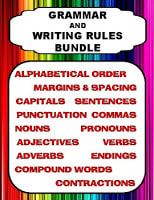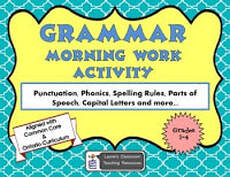Tips on How to Teach Grammar in Your ClassroomCall me old fashioned, but I believe establishing a sound foundation in grammar in the early grades remains important and can be easily integrated into all aspects of a language arts program. In this blog I will provide an overview of how I plan and teach my grammar program for Grades 2 and 3. My approach involves:
The next five days are spent doing what I refer to as grammar search which involves practising the symbols using a poem as detailed below. Once the students understand the system, a different student each week is given the job of symbol drawer and the teacher becomes an observer. Grammar First During the first class, I will start the lesson by discussing which letters of the alphabet are vowels and consonants. As a class, we say the two sounds of vowels and then I demonstrate the symbols used to show if a vowel is a long or short sound in a word. Simplify with Symbols I use a symbol based system that I have created that the students can use to identify various letter combinations such as blends, long and short vowels (mentioned above), endings and language rules of writing, etc. For example, for the word “the”, I have a symbol (a tongue sticking out because your tongue sticks out when you say “th”) that shows the blend “th” is one blended sound and not two separate sounds. We say “th e”, not “t he”. I use a variety of symbols that help students recognize many other phonic blends. I then move onto ending sounds such as “ing”. To help the students remember this sound, I use a ringing bell symbol which would be placed above the “ing”. After teaching a lesson, I will display a poster of the symbols that have been covered. I have a total of five posters that cover the full symbol system. Teaching Tips I regularly use poems, which are a core requirement in our system, or short stories, to teach the various phonic sounds and symbols. I will enlarge and laminate a poem so that students can draw symbols on it with washable markers. I read the entire poem aloud with the students and discuss the type of poem it is and who the author is. I will expose two sentences on the enlarged poem or story per day. I will ask the class what elements of grammar they see in these two sentences. A student will say “I see a capital on the word May.” I will ask why there is a capital on the word and what symbol should I draw? This exercise will continue until we have marked all of the elements that have been taught to this point such as capitals, periods, endings, etc. This activity usually takes about fifteen minutes. Once the students are familiar with the symbols, I assign one student per week to become the symbol drawer for the rest of the class which entails standing at the chart stand and drawing the symbols based on input from the other students. The use of symbols is a very important part of this system since students can easily associate a descriptive visual symbol with a grammar element which aids in remembering new concepts. Repeating this activity on a daily basis further reinforces the acquisition of grammar and writing rules.  Start every month with a Grammar lesson At the beginning of every month, I teach a specific lesson on a different grammar topic – capitals, punctuation, nouns, verbs, adverbs, adjectives, pronouns, endings, etc. I begin every grammar lesson with a read aloud grammar book. These books are available through suppliers such as Scholastics. The book will be discussed followed by a lesson and then activities to reinforce the lesson. I have individual lessons for each grammar and writing rule concept as well as the complete Grammar Writing Rules Bundle for sale at my TpT store, Laurie’s Classroom. The Grammar Writing Rules Bundle contains all lesson plans, activities, assessments as well as posters for the entire school year. Students will add a new symbol for each of these new lessons to their Grammar Morning Work activity. This progresses through the year as new grammar elements are added. I will also incorporate grammar into other language lessons such as writing. I will remind the students of the grammar lesson taught that month and make that one of the elements in my assessment of their writing. The symbols can also be used to help students in their reading since they can apply the system to sound out new words they are not familiar with. The full Grammar Morning Work package is available at my TpT store, Laurie’s Classroom. This package includes step by step instructions on how to teach the symbol system, five posters illustrating the symbols, and two poems. Please visit Laurie’s Classroom, to check out all of my teaching products and free materials. To get notices of TpT sales and new products, please follow me! Stay tuned for my next blog. Happy teaching. Laurie
0 Comments
Leave a Reply. |


